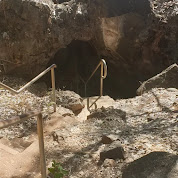While touring around Borroloola and the Gulf Region of the Northern Territory, a visit to the Caranbirini Conservation Reserve is worth a look (or Garambarini as the locals call it and regard it as one of their favourite places). It is approximately 45 kilometres south of Borroloola and 705 kilometres southeast of Darwin. This area is also protected. You must remember to take with you some water, some snacks if you want to take your time and look for wildlife and of course your camera, a good hat and walking shoes. Use insect repellent, (yes there are plenty of flies and other insects) and do not sit on the ground to protect against mosquitos and mites that can carry disease. Remember that snakes are around in the bush so be aware of your surroundings and enjoy. Do you need a 4wd? No, the Reserve is accessible by car with 500m of gravel road from the main highway. You are not allowed to camp in the reserve.
 |
Wren resting on a water lily
|
There are 3 walks that you can take: -
- Carabarini waterhole - 10 minutes from the carpark. 200 metres return and easy to navigate. The bird hide overlooks a waterhole that has a variety of life. If you have a wheelchair, you may be able to complete this trail. There is a ramp into the bird hide.
2. Barrawulla Loop - A short walk
2klm loop,
approximately 2 hours
Grading is easy.
3. Jagududgu Loop - 7.5 klm loop approx.
4-5 hours depending on how often you stop.
grading 3 - moderate.
We visited the waterhole first and searched to find as many different types of wildlife as possible. Our visit was during the dry season and the waterhole was small and drying up slowly. We did see some long neck turtles, a hawk, small birds, butterflies and dragonflies. The waterhole is also popular for freshwater mussels. Take your time with the bird hide and you never know what you might see visiting the water for a drink. Early morning and late afternoon are a popular time to visit to see animals.
 |
tall structures
|
From here we went back to the fork in the trail and began our adventure into the wonders of the 'lost city'. Sandstone formations that can leave you lost for words and your mind full of questions. The varying shapes and sizes are amazing. As you walk amongst them you get a feeling of stepping back in time, almost like the world has stopped. Out there it is just you and whomever you are with, of course, and the wildlife. There is a track to follow and signs to help you find your way.
Some of the pillars, as they are known, can be up to 25 metres high and come in many shapes and forms. There was one that was leaning on another pillar. Looking at it makes you wonder what would happen if it actually fell and hit the ground. Would it make others like it fall or just crumble as it is predominantly sandstone. They blend in with the countryside in colours and would be amazing to see with a sunrise or sunset around them. The ripple marks on the rock are similar to those formed on a sandy beach at low tide. In the hotter months a good time visit would be early morning or late afternoon and please don't visit during the heat of the day. Even though there can be plenty of shade around and near the formations the humidity can be very high.
 |
| Diagonal grooves in the stone |
While we did see animal tracks in the dirt, we were not lucky enough to see goannas or other larger animals. If you are there at the right time you might see Brolga, Jabiru, whistling ducks, kingfishers, herons, and other breeds of birds. Along the way there was some small trees that were trying to grow out of the side of some structures. While walking amongst the pillars with one track leading through and under some overhangs, the air was cooler there and it felt like walking into unknown territory. Are there animals hiding there out of the heat of the day or is it just their home? If you allow yourself to get lost in the moment, it can give you an idea of what the first explorers may have felt like. Walking amongst these pillars and rocks, a bushland unlike what they had seen or experienced before. You get a feeling of being a small person in a large world.
 |
| Many pillars to see and experience |
There is an area on one of the trails with a sign that states that part of the area is a scared site, and we are not allowed to enter. Jagududgu the emu and Barrawulla the white Cockatoo, form part of a dreaming trail that passes through the area. We did see plenty of white cockatoos in the trees while we were exploring the area.
We only took photos and memories from this place, and they are the ones we are sharing with you today. Things may change with the weather and rain since we visited here, though we encourage you to explore the area and the Lost city. Take your time and rest, stop, look and listen, you never know what you may find, see or hear. Some say there is a good chance of finding some "Toonbarri" (sugar bag. honey or honeycomb from the wild) under the rock ledges or in hollow trees. Sandstone structures like these are across much of Northern Australia and eroded organ pipe formations like these at Caranbirini are common throughout the Gulf region.
🐸🐸When you visit the reserve what animals
will you see?
 |
One pillar with a flat surface.
|
 |
| Large and high structures. |









Comments
Post a Comment